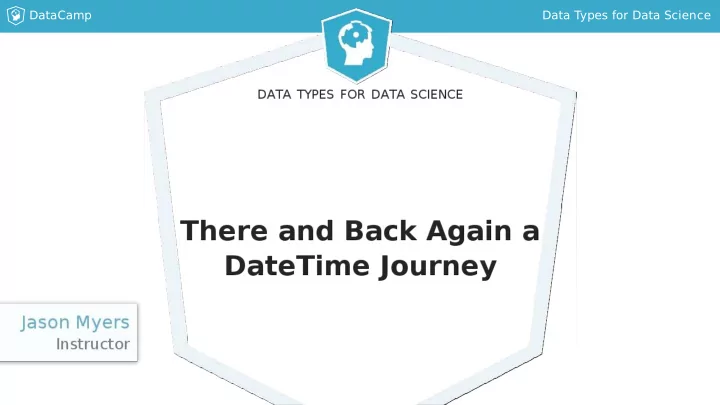

DataCamp Data Types for Data Science
DataCamp Data Types for Data Science From string to datetime The datetime module is part of the Python standard library Use the datetime type from inside the datetime module .strptime() method converts from a string to a datetime object In [1]: from datetime import datetime In [2]: print(parking_violations_date) 06/11/2016 In [3]: date_dt = datetime.strptime(parking_violations_date, '%m/%d/%Y') In [4]: print(date_dt) 2016-06-11 00:00:00
DataCamp Data Types for Data Science Time Format Strings Directive Meaning Example %d Day of the month as a zero-padded 01, 02, ..., 31 decimal number. %m Month as a zero-padded decimal 01, 02, ..., 12 number. %Y Year with century as a decimal 0001, 0002, ..., 2013, 2014, number. ..., 9998, 9999 Full list available in the Python documentation
DataCamp Data Types for Data Science Datetime to String .strftime() method uses a format string to convert a datetime object to a string In [1]: date_dt.strftime('%m/%d/%Y') Out[1]: '06/11/2016' isoformat() method outputs a datetime as an ISO standard string In [1]: date_dt.isoformat() Out[1]: '2016-06-11T00:00:00'
DataCamp Data Types for Data Science DATA TYPES FOR DATA SCIENCE Let's practice!
DataCamp Data Types for Data Science DATA TYPES FOR DATA SCIENCE Working with Datetime Components and current time Jason Myers Instructor
DataCamp Data Types for Data Science Datetime Components day , month , year , hour , minute , second , and more are available from a datetime instance Great for grouping data In [1]: daily_violations = defaultdict(int) In [2]: for violation in parking_violations: ...: violation_date = datetime.strptime(violation[4], '%m/%d/%Y') ...: daily_violations[violation_date.day] += 1 In [3]: print(sorted(daily_violations.items())) [(1, 80986), (2, 79831), (3, 74610), (4, 69555), (5, 68729), (6, 76232), (7, 82477), (8, 72472), (9, 80415), (10, 75387), (11, 73287), (12, 74614), (13, 75278), (14, 81803), (15, 79122), (16, 80692), (17, 73677), (18, 75927), (19, 80813), (20, 80992), (21, 78138), (22, 81872), (23, 78104), (24, 63490), (25, 78898), (26, 78830), (27, 80164), (28, 81954), (29, 80585), (30, 65864), (31, 44125)]
DataCamp Data Types for Data Science What is the deal with now .now() method returns the current local datetime .utcnow() method returns the current UTC datetime In [1]: from datetime import datetime In [2]: local_dt = datetime.now() In [3]: print(local_dt) 2017-05-05 12:30:00.740415 In [4]: utc_dt = datetime.utcnow() In [5]: print(utc_dt) 2017-05-05 17:30:05.467221
DataCamp Data Types for Data Science Timezones Naive datetime objects have no timezone data Aware datetime objects have a timezone Timezone data is available via the pytz module via the timezone object Aware objects have .astimezone() so you can get the time in another timezone
DataCamp Data Types for Data Science Timezones in action In [1]: from pytz import timezone In [2]: record_dt = datetime.strptime('07/12/2016 04:39PM', ...: '%m/%d/%Y %H:%M%p') In [3]: ny_tz = timezone('US/Eastern') In [4]: la_tz = timezone('US/Pacific') In [5]: ny_dt = record_dt.replace(tzinfo=ny_tz) In [6]: la_dt = ny_dt.astimezone(la_tz) In [7]: print(ny_dt) 2016-07-12 04:39:00-04:00 In [8]: print(la_dt) 2016-07-12 01:39:00-07:00
DataCamp Data Types for Data Science DATA TYPES FOR DATA SCIENCE Let's practice!
DataCamp Data Types for Data Science DATA TYPES FOR DATA SCIENCE Time Travel (Adding and Subtracting Time) Jason Myers Instructor
DataCamp Data Types for Data Science Incrementing through time timedelta is used to represent an amount of change in time Used to add or subtract a set amount of time from a datetime object In [1]: from datetime import timedelta In [2]: flashback = timedelta(days=90) In [3]: print(record_dt) 2016-07-12 04:39:00 In [4]: print(record_dt - flashback) 2016-04-13 04:39:00 In [5]: print(record_dt + flashback) 2016-10-10 04:39:00
DataCamp Data Types for Data Science Datetime differences Use the - operator to calculate the difference Returns a timedelta with the difference In [1]: time_diff = record_dt - record2_dt In [2]: type(time_diff) Out[2]: datetime.timedelta In [3]: print(time_diff) 0:00:04
DataCamp Data Types for Data Science DATA TYPES FOR DATA SCIENCE Let's practice!
DataCamp Data Types for Data Science DATA TYPES FOR DATA SCIENCE HELP! Libraries to make it easier Jason Myers Instructor
DataCamp Data Types for Data Science Parsing time with pendulum .parse() will attempt to convert a string to a pendulum datetime object without the need of the format string In [1]: import pendulum In [2]: occurred = violation[4] + ' ' + violation[5] +'M' In [3]: occurred_dt = pendulum.parse(occurred, tz='US/Eastern') In [4]: print(occured_dt) '2016-06-11T14:38:00-04:00'
DataCamp Data Types for Data Science Timezone hopping with pendulum .in_timezone() method converts a pendulum time object to a desired timezone. .now() method accepts a timezone you want to get the current time in In [1]: print(violation_dts) [<Pendulum [2016-06-11T14:38:00-04:00]>, <Pendulum [2016-04-25T14:09:00-04:00]>, <Pendulum [2016-04-23T07:49:00-04:00]>, <Pendulum [2016-04-26T07:09:00-04:00]>, <Pendulum [2016-01-04T09:52:00-05:00]>] In [2]: for violation_dt in violation_dts: ...: print(violation_dt.in_timezone('Asia/Tokyo')) 2016-06-12T03:38:00+09:00 2016-04-26T03:09:00+09:00 2016-04-23T20:49:00+09:00 2016-04-26T20:09:00+09:00 2016-01-04T23:52:00+09:00 In [3]: print(pendulum.now('Asia/Tokyo')) <Pendulum [2017-05-06T08:20:40.104160+09:00]>
DataCamp Data Types for Data Science Humanizing differences .in_XXX() methods provide the difference in a chosen metric .in_words() provides the difference in a nice expresive form In [1]: diff = violation_dts[3] - violation_dts[2] In [2]: diff Out[2]: <Period [2016-04-26T07:09:00-04:00 -> 2016-04-23T07:49:00-04:00]> In [3]: print(diff.in_words()) '2 days 23 hours 20 minutes' In [4]: print(diff.in_days()) 2 In [5]: print(diff.in_hours()) 71
DataCamp Data Types for Data Science DATA TYPES FOR DATA SCIENCE Let's practice!
Recommend
More recommend